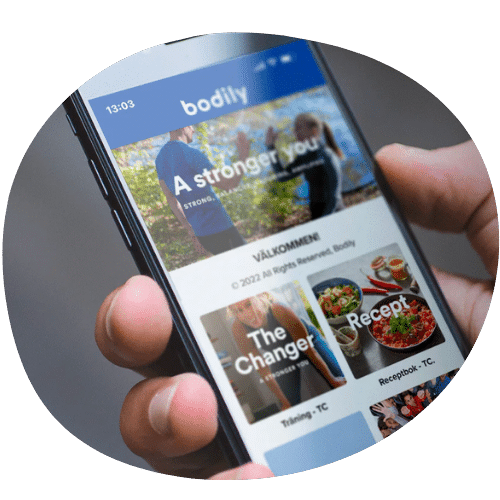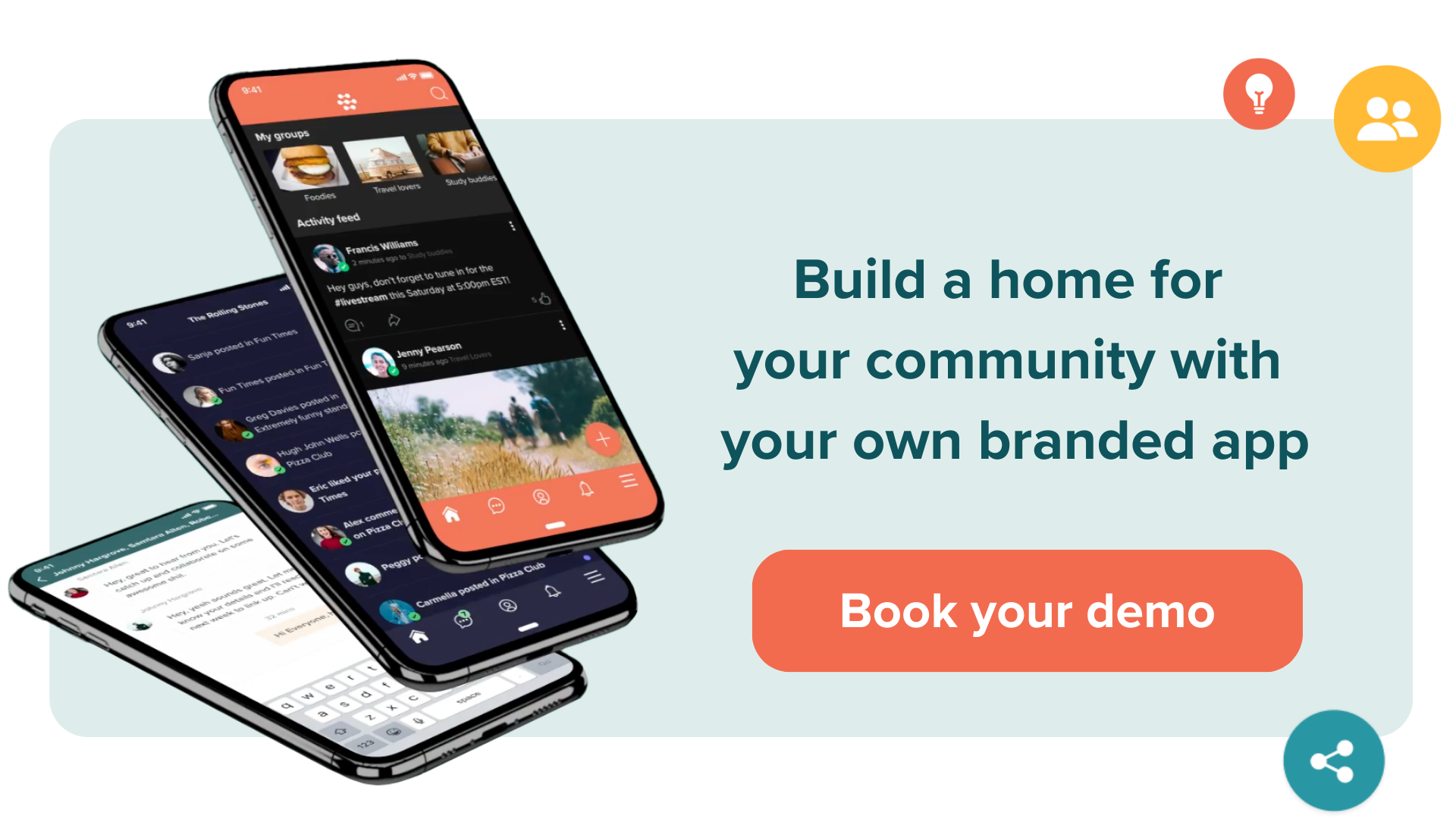The Ultimate Guide to Online Memberships
- 21/02/2024
The Ultimate Guide to Online Memberships
- 21/02/2024
Welcome to the Ultimate Guide to Memberships, your definitive playbook for creating a membership business that is sustainable, profitable and, most importantly, enables your members to enjoy meaningful connection and transformation.
As pioneers in the field, we’ve distilled our insights from engaging with over 600 community businesses into this comprehensive guide, serving as a compass for your journey towards membership success.

This guide is for you if you’re grappling with understanding memberships and how the model could work for your business. We’ll dive into the following topics in depth:
Understanding the membership economy
In the ever-evolving world of digital communities, the membership economy stands as a beacon of innovation and sustainability. But what exactly does it entail? Our guide not only demystifies the membership economy but also offers a roadmap for leveraging its vast potential.
Why memberships matter: Exploring the business opportunity
Delve into the core of why memberships matter now more than ever. From the rise of online identity to the yearning for belonging in real-life, discover the compelling forces driving the ascent of membership models across diverse sectors. Uncover the unique business opportunities presented by memberships, both for individuals and institutions, and explore how online memberships are reshaping the business landscape.
Crafting your membership: From concept to creation
Embark on a journey of self-discovery as we unravel the critical question: Should I run a membership? Explore the pain points of existing models and weigh the advantages of embracing a membership model tailored to your unique vision. Learn to structure and price your membership for maximum impact, while gaining insights into launching, selling and promoting your offering with finesse.
Setting up your membership: From tools to tactics
Navigate the practical intricacies of setting up your membership business with confidence. From hosting and migrating your members to selecting the right tools for seamless operation, we equip you with the essential knowledge to transform your vision into reality.
Managing your membership business: Strategies for success
Embrace the twin pillars of growth and engagement as we unveil strategies for nurturing a thriving membership community. Learn how to attract and retain members, harness the power of analytics for informed decision-making, and foster meaningful connections that endure the test of time.
Your path to membership success
Armed with actionable insights and proven strategies, you’ll finish this guide poised to embark on a transformative journey towards membership success.
Get ready to unlock the full potential of your community: Welcome to the Ultimate Guide to Memberships!
Part One: Why memberships matter
In today’s fast-paced digital world, there’s an exciting trend taking shape: The rise of online memberships. It’s a move towards more vibrant, long-lasting connections between businesses and their communities.
This section is all about exploring why memberships are becoming the heart of success for creators, entrepreneurs, and institutions alike, shining a spotlight on their crucial role in shaping the digital economy.
1. What role do online memberships play in society?
1. Start every member’s journey with a warm welcome
Learn more about warm welcomes
- Quick Bite Webinar: ‘Engagement in your community’
The rise of online memberships is a response to the evolving needs of society and individuals alike. This shift underscores a deeper quest for online identity and a sense of belonging that people are struggling to find through real-life interactions. As we navigate through the complexities of digital transformation, the importance of membership models becomes ever more apparent, serving as vital conduits for community, identity and transformation.

The internet is an increasingly important stage for expressing and exploring identity. Online platforms offer opportunities for individuals to define themselves, connect with like-minded communities and engage in shared experiences that resonate with their interests and values.
However, as the digital landscape becomes more crowded and commercialized, the quest for authentic online identities has led to a growing disillusionment with mainstream social media platforms.
- Personalization and authenticity: Membership models emerge as a sanctuary for authenticity in an online world dominated by broad and impersonal interactions. They provide a space where individuals can curate their digital presence, share genuine experiences and engage in meaningful dialogues, all of which are crucial for the development of a coherent online identity.
- Control over digital footprint: Unlike open social networks, membership platforms offer greater control over who sees and interacts with your content. This control is essential for fostering a safe environment where individuals feel comfortable expressing their true selves, free from the judgment and noise of larger platforms.
As society becomes more digital and transient, many people are struggling to find community. This loss has propelled the search for new forms of connection, with many finding solace and belonging in online spaces.
- Creating digital communities: Membership models have been pivotal in creating digital communities that offer a sense of belonging. These platforms enable individuals to find and connect with others who share similar interests, challenges, and goals, forming bonds that transcend geographical limitations.
- Interactive and supportive networks: Through curated content, shared experiences, and interactive features, membership sites facilitate a supportive network where members can offer and receive guidance, encouragement and recognition. This interactive support system plays a crucial role in replicating the communal support once found in physical communities.
The growing importance of membership models in today’s digital landscape is a testament to the shifting dynamics of how we seek identity, belonging and community. As traditional avenues for connection and self-expression diminish, membership platforms offer a new way to build and sustain communities that cater to the diverse needs of individuals and groups alike.
For businesses, creators and individuals, understanding and leveraging the potential of these models is key to thriving in an increasingly digital world and helping people to transform their lives and feel connected.

2. What’s the business opportunity in memberships?

The allure of membership models lies in their ability to forge deeper, more meaningful connections.
For individuals such as online creators and coaches, this translates to a direct pathway to monetize their passion and expertise through recurring revenue streams. The intimacy of these models allows for personalized content delivery and fosters a sense of belonging among members.
For institutions, the strategic implications are equally compelling. Startups, for example, are leveraging memberships as a growth catalyst, using the power of community to amplify customer engagement and loyalty. This community-centric approach not only accelerates product adoption but also opens up new avenues for feedback and innovation, proving invaluable in today’s fast-paced market.
- Sustainable revenue streams: At the heart of the membership model lies the promise of recurring revenue, a holy grail for any business. Unlike the unpredictable nature of one-time sales or ad-based revenue models, memberships offer a steady and predictable income stream. This stability is invaluable for long-term planning and investment in quality content and services.
- Enhancing customer lifetime value: Membership models excel in transforming casual consumers into committed members, significantly enhancing customer lifetime value. Through recurring engagements and renewals, businesses can cultivate a more profitable relationship with their audience over time, far surpassing the financial returns of episodic transactions.
- Building meaningful relationships: Memberships transcend traditional customer-business interactions by fostering a sense of belonging and community among members. This deepened engagement breeds loyalty, transforming members into brand advocates who are more likely to support and promote the business.
- Tailored experiences: The membership model allows for the personalization of content and services, meeting the specific needs and preferences of each member. This personal touch not only enhances member satisfaction but also elevates the perceived value of the membership, encouraging retention and word-of-mouth marketing.

- Informed business decisions: The continuous interaction inherent in membership models provides businesses with a wealth of data on member preferences, behaviors and feedback. This data is a goldmine for informed decision-making, allowing businesses to refine their offerings, improve member satisfaction and innovate with confidence.
- Predictive analytics for growth: Beyond reactive adjustments, the rich data landscape of memberships enables predictive analytics, helping businesses anticipate member needs, forecast trends, and stay ahead of the competition.
- Reaching new segments: Membership models, especially those built around niche interests or industries, can tap into previously under-served market segments. By catering to specific needs and fostering dedicated communities, businesses can unlock new audiences and revenue streams.
- Global reach: The digital nature of membership platforms allows businesses to transcend geographical limitations, accessing a global audience. This expanded reach is a game-changer for scalability, enabling businesses to grow their member base and impact far beyond local boundaries.

The business opportunity presented by membership models is profound and multifaceted. By offering a sustainable revenue model, deepening customer engagement, leveraging data for innovation and expanding market reach, memberships give modern businesses a strategic advantage.
For those willing to embrace this model, the potential for growth, innovation and long-term success is boundless. The future of digital engagement and revenue generation is here, and it is intrinsically linked to the thoughtful implementation of membership models.
Going even further than profiles:
- Read blog: ‘User badges, member directories and more’
3. Which sectors are implementing membership models?

Memberships are revolutionizing the way coaches, creators and various institutions engage with their audiences. This strategic shift towards memberships is creating new opportunities for sustainable revenue, deeper engagement and community building across multiple sectors. Here’s a deeper look into the expansion of membership models:

- Extended support and resources: Coaches across fields from wellness to business are adopting membership models to provide clients with ongoing resources, community support and continuous learning paths. Crucially, membership models allow coaches to break free from the limitations of 1-1 coaching so that they can scale their businesses and reach more people.
- Engagement and personal development: This model allows for a more holistic approach to coaching, facilitating a space where clients can grow at their own pace, supported by both coaches and peers.
3. Be responsive, lead by example don’t miss out!
- Diverse creator engagement: Artists, writers, musicians and educators are increasingly leaning into memberships to connect directly with their audience, moving beyond traditional ad-supported or product-based revenue models.
- Platform support: Platforms like Disciple Media and others are pivotal, offering creators tools to easily monetize exclusive content and foster a supportive community, emphasizing the shift towards direct creator-audience relationships.

- Integrating community with growth: More startups are viewing community as an integral part of their product and growth strategy, leading to more authentic engagement and sustainable growth.
- Community-driven growth: Leveraging community as a core strategy, startups are engaging users in product development and brand advocacy, enhancing customer loyalty and retention.
- Balancing product and community focus: The discussion between prioritizing product development or community engagement is evolving, with successful startups often finding a harmonious balance that leverages the strengths of both approaches.
- Venture Capital (VC) interest: The VC world shows increasing interest in startups that effectively build and manage communities, recognizing the long-term value and stability these engaged audiences offer.

- Deepening connections through memberships: These groups are exploring how memberships can strengthen networks, provide exclusive benefits and create new avenues for engagement and support.
The spread of online membership models across various sectors represents a fundamental shift in how value is created, delivered and sustained. From empowering creators and transforming coaching to reshaping how startups grow and attract investment, memberships are at the forefront of building deeper, more meaningful connections in the digital ecosystem.
As we move forward, the role of memberships in fostering community, enhancing engagement and driving sustainable revenue growth will only become more pronounced, offering a blueprint for success in the evolving digital economy.
More about community leadership:
- Masterclass Webinar: ‘How to embody leadership’
4. What’s the role of community in memberships?
4. Moderate firmly but fairly to keep trust and order in your community
Community is vital in membership models – it’s what brings people together and makes the membership feel like home.
Here are 5 reasons that community is essential:
1. Collective learning: Members share insights, troubleshoot problems, and celebrate successes, fostering continuous learning.
2. Authentic connections: Beyond transactions, communities forge genuine bonds based on shared interests and values, creating a sense of belonging.
3. Impactful collaboration: Together, members drive meaningful change and amplify their influence by rallying around causes and initiatives.
4. Supportive environment: Communities offer encouragement, accountability and motivation, empowering members to pursue their goals with confidence.
5. Innovative spark: By bringing together diverse perspectives, communities fuel creativity and innovation.
We typically see two distinct approaches to incorporating community into memberships: monetizing paid communities and including community as part of a bundle of other offerings.
The concept of a paid community revolves around the idea of offering exclusive access to a curated space where members can interact, share, and learn from each other and from experts. This model capitalizes on the intrinsic human desire for belonging and connection, providing a platform for deep engagement around shared interests or goals.
Why it’s emerging:
- Demand for authentic connection: In an increasingly digital world, individuals seek genuine connections and communities where they can find support, inspiration and camaraderie.
- Expertise and exclusivity: There’s a growing willingness to pay for access to specialized knowledge, mentorship and exclusive content that isn’t available in the public domain.
- Sustainability for creators: For creators and thought leaders, paid communities offer a sustainable revenue stream, allowing them to focus on delivering value to a dedicated audience.
Strategic implications:
- Deep engagement over broad reach: This model prioritizes depth of engagement with a smaller, more committed group of members over reaching a large, less engaged audience.
- Community as the product: The community itself, with its interactions, shared learning and networking opportunities, becomes the primary source of value.
Alternatively, some models bundle access to a paid community with additional offerings, such as courses, digital products, exclusive events or services. This approach broadens the value proposition, appealing to those looking for comprehensive solutions or experiences.
Why it’s emerging:
- Diverse needs and preferences: Members have varied needs and learning styles, prompting creators and coaches to offer a wider array of resources and touchpoints.
- Increased value perception: By bundling community access with other products or services, businesses can enhance the perceived value of their membership, justifying higher price points or attracting a broader audience.
- Cross-promotion and upselling opportunities: Bundles offer a strategic avenue for cross-promoting services and upselling members to higher tiers or additional offerings.
Strategic implications:
- Holistic solutions over singular offerings: This model shifts the focus from providing a singular offering to delivering a comprehensive suite of solutions that cater to multiple aspects of the member’s journey.
- Enhanced member lifecycle management: Bundles allow for more touchpoints with members, facilitating ongoing engagement and opportunities to deliver value across different stages of the member’s journey.

The emergence of these distinct business models within the digital membership landscape underscores a broader trend towards more nuanced and sophisticated strategies for engagement and monetization.
Whether focusing on the depth of connection in paid communities or the breadth of value in bundled offerings, the underlying theme is a shift towards recognizing and catering to the diverse needs, preferences and values of digital audiences. We dive into a lot more detail on the different membership models available in the next section, so keep reading to learn what will work best for your business!
As we move forward, the choice between these models will depend on a strategic assessment of your audience, goals and the unique value you can offer. Ultimately, the success of any membership model lies in its ability to foster meaningful engagement, deliver tangible value, and build a sense of community and belonging among your members.
More about community moderation
- Quick guide: ‘4 ways to moderate and keep the right people’
Part Two: How to create a membership
In this section, we explore membership as a business model and why it is becoming increasingly popular amongst coaches and creators. This detailed guide is designed to help you learn about memberships and evaluate honestly whether it is a model worth implementing in your own business. We’ll explore the ins and outs of how to structure and set up a membership.

5. Should I run a membership?
What common challenges do creators and coaches face in their business models?

Understanding the pain points in existing business models is crucial for creators and coaches considering the transition to a membership model. At Disciple, we’ve worked closely with over 600 businesses in their journey to setting up a membership.
Here are the common challenges that we routinely hear from coaches and creators before they create their membership:
- Scalability: Traditional coaching, especially in one-to-one settings, is inherently limited by the number of hours in a day, making it difficult to scale income without increasing workload.
- Inconsistent income: Income can fluctuate based on the number of clients and the variability in client engagement, making financial planning challenging.
- Limited reach: Personalized coaching can only impact a limited number of people at a time, restricting the coach’s potential influence and reach.
- Burnout: Income is directly tied to active involvement. This can lead to burnout as coaches try to meet increasing demand without the corresponding increase in capacity. Coaches often try to mitigate this by introducing additional tools, but this leads to a fragmented and complex toolset that doesn’t properly integrate.
- Difficulty in productizing expertise: Many coaches struggle to convert their knowledge and expertise into scalable products or services that don’t require their direct time and effort.
- Client retention and progress tracking: Retaining clients in a one-on-one model can be challenging, as can tracking and ensuring their progress, especially when dealing with a larger client base.
- Market differentiation: Standing out in a crowded coaching market requires unique offerings, which can be challenging to develop and market effectively. It can be difficult for coaches to build their brand when the majority of their time is consumed by one-to-one coaching.
Common challenges for creators
- Monetization: Creators often rely on selling low-priced products like e-books, courses, art, or music, where income can be inconsistent and often doesn’t reflect the effort put into creating them.
- One-time sales limitations: The reliance on one-time sales can lead to financial instability. Once a product is sold, creators must continually develop new products to maintain income.
- Lack of control: Creators are building their businesses on third-party social media platforms like Facebook and Instagram that they don’t own or control. This puts their business at risk and can reduce audience trust.
- Market saturation and competition: With the rise of digital platforms, creators face intense competition, making it challenging to stand out and monetize effectively.
- Customer retention issues: Engaging customers beyond a single purchase can be difficult. Without a recurring relationship, the opportunity to maximize customer lifetime value is limited.
- Lack of audience engagement: Selling individual products often lacks the mechanism to build a deep, ongoing relationship with the audience, which is essential for brand loyalty and repeat business.
What are the advantages of a membership model?
Shifting to a membership model can help coaches and creators overcome these challenges. While changing to a membership model is not a quick fix and still involves a lot of hard work, the benefits can be significant. Here’s a run down of the advantages we typically see:

Stable, recurring revenue
- Predictability and financial stability: The recurring nature of memberships provides a predictable and stable revenue stream, which is crucial for long-term financial planning and business sustainability.
- Cash flow management: Regular income aids in better cash flow management, allowing businesses to allocate resources more effectively and plan for growth and investment with greater confidence.
Scalability

- Leveraging digital platforms: With the integration of digital platforms, businesses can serve an exponentially larger audience without a significant increase in workload or costs, breaking the traditional barriers of physical and time constraints.
- Product and service diversification: Membership models enable businesses to diversify their offerings more easily. As the audience grows, businesses can scale up by introducing new tiers, content, or services tailored to different segments of their membership base.
Community building
- Enhanced customer loyalty and engagement: Building a community around your brand or service leads to stronger customer loyalty. Members who feel part of a community are more likely to stay subscribed and advocate for the brand.
- Feedback and innovation: A vibrant community becomes a source of continuous feedback, allowing businesses to innovate and improve their offerings in line with member needs and preferences. This feedback loop is invaluable for staying relevant and competitive.
Passive income
- Reduced active involvement: Once the membership model is established and the content or service delivery systems are in place, it can offer a more passive income stream compared to traditional business models. We’re not saying it’s easy, but the right set up can make your business far more efficient.
- Automation and systems: The use of automation tools and systems in managing memberships — such as automated billing, content delivery, and community management — reduces the need for constant active involvement, allowing business owners to focus on strategic growth and other ventures.

Additional benefits
- Building brand authority: Regular interaction with members through high-quality content and services establishes your brand as an authority in your niche, enhancing your market reputation.
- Independent platforms offer full control: Choosing an independent platform allows you to take back control of your business from social media giants.
- Long-term customer relationships: The membership model fosters long-term relationships with customers, providing a deeper understanding of their needs and preferences, which is invaluable for targeted marketing and product development.
- Customization and personalization opportunities: With a deeper understanding of your member base, there’s an opportunity to offer highly customized and personalized experiences, further increasing member satisfaction and retention.

In summary, a membership model can be transformative for businesses seeking sustainable growth, scalability, and a deeper connection with their customers. A simple but valuable membership offering built on the right platform can unlock huge benefits for both your customers and your business.
Highly engaged segments:
- Expert Livestream: ‘Find and motivate your super members’
Is a membership model suitable for my business?
Determining whether a membership model aligns with your business strategy requires a thorough assessment of various factors, including the economic feasibility, the nature of your audience, and the potential for community building.

Understanding the economics of your membership
- Analyzing market size and potential: Evaluate the size and purchasing power of your target audience. Is there a sufficient number of potential members willing to pay for your offering? Conduct market research to gauge interest and willingness to pay.
- Assessing pricing models: Crafting the right pricing strategy is a balancing act – we go into this in far more depth in the section on structuring your membership. It should reflect the value provided while remaining affordable for your target audience. Consider factors like competitor pricing, perceived value, and the exclusivity of the content or services offered.
Community vs. audience

- Recognizing the difference: An audience is a group of followers or consumers, while a community implies a higher level of engagement and interaction. Which one do you currently have?
- Transitioning from audience to community: If you currently have an audience, consider strategies to foster more interaction and engagement to build a community. This transition is critical for the success of a membership model.
Ideal audience structure for membership
- Engagement and interaction: To best set your membership up for success, it helps if you’ve already built an engaged audience. Look for indicators of engagement such as regular interaction with your content, high levels of participation in events or webinars, and active discussions.
- Shared identity and common interests: An audience that shares a common identity or set of interests is more likely to form a cohesive community. This shared identity is the glue that holds the community together and can be a driving force in the success of a membership model.
Indicators of readiness for a membership model
- Observing organic interactions: Instances like friendships forming in social media comments or discussion forums indicate a naturally evolving community. These organic interactions are a positive sign that your audience is ready to engage at a deeper level.
- Holistic engagement beyond core content: Are the discussions among your audience extending beyond the core subject matter of your expertise? If your audience is engaging in broader, holistic life improvement topics, it indicates a deeper level of engagement and readiness for a more comprehensive membership model.

Cultivating a membership-ready audience
- Nurturing engagement: Proactively encourage interactions within your audience. Create content that prompts discussion, and foster a sense of belonging and community.
- Providing value: Consistently deliver value that goes beyond basic expectations. This could be in the form of exclusive content, personalized interactions, or opportunities for members to contribute and be recognized.

In conclusion, transitioning to a membership model is not merely a business decision but a strategic move that hinges on the nature of your relationship with your audience. It requires a clear understanding of the economics involved, a strong, engaged community foundation, and the ability to cultivate and nurture an environment conducive to a successful membership ecosystem. The readiness of your audience, marked by engagement, shared identity, and holistic interaction, is as crucial as the economic feasibility of the model itself.
Is it the right time to switch to a membership model?
Deciding whether to adopt a membership model requires a comprehensive assessment of your current business situation, audience dynamics, and available resources. Here’s a detailed exploration of these factors:
Current business model limitations

- Revenue fluctuations: If your current revenue is unpredictable, causing stress and hindering long-term planning, a membership model could offer more stability.
- Market saturation: Are your products or services facing stiff competition, leading to decreased market share or price pressures? A membership model can differentiate your offerings.
- Customer lifecycle: Analyze your customer lifecycle. If you’re only engaging customers in one-off transactions, you’re missing out on the long-term value a membership model can bring through repeat engagement.
- Value maximization: Assess whether your current model fully leverages the value you could provide. A membership model can deepen customer relationships, enhancing the perceived and delivered value.
Audience readiness
- Engagement level: Do your customers frequently return for more content, advice, or products? High engagement levels are a good indicator that your audience might appreciate and commit to a membership.
- Community indicators: Look for signs of a community forming around your brand or content. This could be through social media interactions, comments on your content, or participation in events and webinars.
- Feedback and requests: Pay attention to customer feedback. If there are frequent requests for more in-depth content, ongoing support, or a community platform, these are strong indicators that your audience is ready for a membership model.
- Loyalty and advocacy: Measure the loyalty of your audience. Loyal customers who advocate for your brand are more likely to join and promote a membership program.
Resource availability
- Time investment: Setting up and managing a membership model is time-intensive, especially in the early stages. Assess whether you can allocate the necessary time or delegate responsibilities effectively.
- Team and expertise: Do you have a team to manage different aspects of the membership model, such as consistent content creation, community management, technical support, and customer service? If not, consider the feasibility of hiring or training staff.
- Technology and infrastructure: Evaluate if you have the right technology to support a membership model. This includes a robust platform for hosting your membership, payment processing capabilities, and tools for communication and content delivery.
- Financial resources: Consider the initial investment required to set up the membership model. This includes technology setup costs, marketing expenses, and any content production costs.

In summary, transitioning to a membership model is a strategic decision that should be made after thorough consideration of your current business challenges, audience engagement and readiness, and the availability of necessary resources and infrastructure. It’s a model that demands commitment but offers substantial rewards in terms of customer loyalty, stable revenue, and the opportunity to build a thriving community around your brand.
6. How do I structure my membership?

How do I define my value proposition and niche?
In the bustling world of memberships, standing out is essential for success! Let’s dive into how to craft a clear and unique value proposition and find your perfect niche.
The power of a unique perspective

- Identify your unique selling proposition (USP): What makes your offering stand out? It could be your unique expertise, your approach, or a specific demographic you serve. Identify the transformation that you will help people create in their lives and exactly how you are equipped to support them. The more specific you can be about what makes you unique, the better!
- Leverage your personal story or experiences: Often, your personal journey can resonate with a specific audience segment. If your story aligns with their challenges or aspirations, it can form a powerful emotional connection. No one else has the same life story as you, so talk openly about why it is that you do what you do!
Crafting a compelling value proposition
- Solving specific problems: Your value proposition should clearly articulate how you solve specific problems or meet specific needs for your audience. How does your membership make their lives better, easier, or more fulfilling?
- Clear and concise communication: Your value proposition should be easily understandable. Avoid jargon and be as clear as possible about the benefits you offer.
Understanding audience growth and development goals
- In-depth audience analysis: Conduct surveys, interviews, or focus groups to gain deep insights into what your audience wants to achieve, learn, or experience. This should go beyond surface-level assumptions and delve into their deeper motivations and challenges.
- Aligning with audience aspirations: Your membership should align with the growth and development goals of your audience. Whether it’s professional development, personal growth, fitness, or hobby-related, understanding these goals helps tailor your content and services to be truly impactful.

Educational and experiential offerings
- Curate content that educates: Ensure that your offerings educate your members in line with their aspirations. This could be through expert articles, webinars, courses, or interactive workshops.
- Create experiences: Offer experiences that facilitate personal growth or skills development, such as group challenges, live coaching sessions, or community projects.

In summary, defining a clear and compelling value proposition and understanding your niche are not just steps in creating a membership model; they are the foundation upon which your membership is built. They determine how effectively you connect with your audience, how well you meet their needs, and ultimately, the success of your membership model. It’s a continuous process of learning about your audience, adapting your offerings, and consistently delivering value that aligns with the specific aspirations and needs of your members.
How do I determine the scope and scale of my membership?
When building a membership model, one of the most critical decisions involves determining the scope and scale of your offering. This decision will significantly impact your marketing strategy, content creation, community management, and overall business model.

Narrow vs. broad membership base
Broad membership base at a lower price point
- Volume-oriented approach: Targeting a larger audience at a lower price point is a volume-oriented strategy. It’s ideal if your content has universal appeal and doesn’t require extensive customization.
- Community dynamics: With a broader membership base, fostering a sense of community can be challenging due to diverse interests and needs. However, this can be mitigated through sub-groups or segmented content.
- Revenue stability: A larger number of members at a lower price point can often lead to more stable and predictable revenue, albeit with thinner margins.
Niche membership at a higher price point
- Exclusivity and specialization: Targeting a niche audience allows for more specialized, high-quality content and services. This exclusivity can justify a higher price point.
- Intense engagement and support: With a smaller group, you can offer more personalized experiences, higher engagement, and better support. This can lead to higher member satisfaction and retention.
- Revenue considerations: While a higher price point with fewer members might seem limiting in terms of revenue, the deeper engagement often translates into longer-term member retention and loyalty.
Deciding which kind of membership base will work for you

Assessing your content and community
- Content specificity: Evaluate how specific your content is. Highly specialized content naturally lends itself to a more niche audience willing to pay a premium.
- Community building: Consider the type of community you want to build. A niche community often offers a more intimate and engaged environment, which can be a significant draw for certain audiences.
Market research and testing
- Surveys and focus groups: Conduct market research to understand what your potential members are looking for and what price they are willing to pay.
- Pilot programs: Consider running a pilot membership program to test the waters. This can provide valuable insights into which model resonates best with your audience.


Financial modeling and projections
- Break-even analysis: Calculate the break-even point for both models. This includes considering the costs of content creation, platform maintenance, marketing, and any other operational expenses.
- Long-term financial projections: Look beyond immediate revenue and consider long-term financial sustainability. Factor in potential growth, churn rates, and the cost of scaling the membership.
Adapting to audience needs
- Feedback loops: Establish mechanisms for ongoing feedback from your members. This will help you understand if your scope and scale are meeting their needs and expectations.
- Flexibility to pivot: Be prepared to adjust your model based on feedback and market trends. The ability to pivot is crucial in the dynamic landscape of membership models.

To conclude, deciding between a broad or narrow membership base involves a deep understanding of your content’s appeal, your capacity for community building and engagement, and a clear analysis of financial implications. It’s a decision that shapes the very nature of your membership model and should be made with a comprehensive understanding of your target audience, market dynamics, and your own business goals and capacities. Regularly revisiting this decision as your membership evolves is crucial for long-term success and sustainability.
How do I craft a compelling offer?
The success of a membership model hinges significantly on what you include in your offering. The right mix of content and features not only attracts members but also keeps them engaged and loyal. Let’s explore how to strategically determine your membership inclusions.

Content and features: Building your core offer
- Exclusive content: This is the heart of your membership. It could be in-depth articles, video tutorials, podcasts, or any other format that delivers value. Exclusive content should be something that can’t be easily found elsewhere and aligns closely with your audience’s interests and needs.
- Community access: Providing access to a community, such as a private forum or social media group, fosters a sense of belonging. This is where members can network, share experiences, and support each other, adding significant value beyond the basic content.
- Educational content and support: Consider how you will support your members’ transformation through self-guided course content and individual or group support. What’s the right balance for your unique community and time restraints?
- Regular webinars or live events: Interactive events like webinars, Q&A sessions, or live workshops encourage active participation and can be a strong draw. They provide real-time engagement with you or other experts, which can be a significant selling point.
- Additional resources: Consider including tools, templates, checklists, or other resources that make it easier for members to apply what they learn.
Balancing exclusivity with accessibility

- Understanding the value of exclusivity: Exclusive offerings make your membership more appealing. It creates a sense of VIP treatment and can justify a higher price point. However, the key is to ensure that this exclusivity doesn’t alienate potential members who might still benefit from some of your offerings.
- Creating tiered access: One way to balance exclusivity and accessibility is to have tiered levels of membership. Basic tiers might offer some general content, while higher tiers provide more exclusive access. This way, you cater to different segments of your audience without diluting the value of your premium offering.
Assessing member needs and preferences
- Continuous member feedback: Regularly gather feedback from your members to understand their satisfaction with the current offerings and what additional content or features they might find valuable.
- Market trends and competitor analysis: Stay informed about market trends and what competitors are offering. This can give you ideas for new inclusions and help you keep your membership fresh and relevant.
Evaluating resource implications
- Content creation costs: Consider the costs and resources required to create and maintain the content and features you plan to offer. High-quality content can be resource-intensive, so it’s important to balance ambition with practicality.
- Scalability: As your membership grows, ensure that the content and features you offer can scale accordingly. Automated systems, scalable community platforms, and evergreen content can help manage growth more effectively.


Determining what to include in your membership is a critical step that requires a deep understanding of your audience’s needs, careful consideration of resource implications, and a strategic approach to balancing exclusivity with accessibility.
The goal is to create a membership offer that delivers tangible value, fosters a sense of community and belonging, and stands out in a crowded market. Regularly revisiting and refining your offerings based on member feedback and market dynamics will help ensure the long-term success of your membership model.
What are the different membership models I could consider?
Ascension model
The ascension model is a popular marketing and sales framework, particularly in membership and subscription-based businesses. It’s characterized by the following:
- Sequential offering: Customers are led through a series of products or services, starting from a low-cost or free entry-level offering and gradually moving up to higher-value and more expensive offerings.
- Building value and trust: Early stages focus on establishing value and building trust. As customers see the benefits of the initial offerings, they are more likely to invest in more advanced, premium options.
- Customer lifecycle management: It’s a strategic approach to customer relationship management, aiming to increase the lifetime value of each customer by encouraging them to ascend through different levels of offerings.
Challenges of the ascension model:
- Balancing value across tiers: Ensuring each level of the model provides sufficient value to justify the cost and motivate customers to ascend can be challenging. There’s a risk of lower tiers feeling neglected or higher tiers not offering enough perceived value.
- Customer journey complexity: Managing and personalizing the customer journey through different levels of the model requires sophisticated segmentation and marketing strategies, which can be resource-intensive and complex to execute effectively.

Flat-rate membership model

Characteristics:
- Uniform offering: Provides all members with the same benefits, services, or products for a single, consistent fee. This model is straightforward and transparent, making it easy for customers to understand what they’re getting.
- Simplicity in marketing: The clarity of the offer can make marketing and sales processes more straightforward.
- Member expectations: Members know exactly what they’re paying for, which can lead to higher satisfaction if the value proposition is strong.
- Revenue predictability: Offers predictable revenue, though it might cap the potential earnings per customer.
Challenges:
- Limited customization: May not adequately cater to the varied needs or preferences of different customer segments.
- Revenue limitation: The flat fee caps the maximum revenue per customer, unlike tiered or ascension models that allow for upselling.
Tiered membership model
Characteristics:
Multiple levels: Offers different membership levels, each with its own set of benefits and pricing. This allows customers to choose a level that matches their needs and budget.
Flexibility and choice: Provides flexibility for customers and caters to a broader range of preferences and willingness to pay.
Upsell potential: While not necessarily sequential like the ascension model, there is still potential to upsell customers to higher tiers over time.
Challenges:
Complexity in marketing and management: More tiers mean more complexity in marketing, managing, and maintaining different levels of service.
Risk of over-segmentation: There’s a risk of confusing potential members with too many options or diluting the value proposition.
Freemium model
Characteristics:
Free basic offering: A basic version of the service is offered for free, with the option to upgrade to premium versions with more features, benefits, or services.
Wide market reach: The free tier can attract a large user base, providing an opportunity to market premium features to a broader audience.
Conversion strategy: Aims to convert a portion of free users into paying customers by showcasing the value of premium features.

Challenges:
Conversion rate management: The success of this model heavily depends on converting a sufficient percentage of free users into paying customers.
Value balance: Balancing the value offered in the free version with the incentives to upgrade is crucial.
Community-centric model
Characteristics:
Community as the core value: The primary value proposition is the community or network itself. Members join for the interactions, connections, and shared experiences rather than just the content or services provided.
Engagement focus: High emphasis on fostering interaction, collaboration, and engagement among members.
Brand loyalty and retention: Strong communities can lead to higher member loyalty and long-term retention.
Challenges:
Community management: Requires active management and moderation to maintain a positive, engaging, and valuable community environment.
Value perception: The value of the community must be clear and compelling to justify the membership cost.
Pay-per-use or consumption-based model

Characteristics:
Usage-based pricing: Members are charged based on their usage or consumption of services or products, rather than a flat fee.
Flexibility for users: Attractive to users who prefer paying only for what they use, potentially lowering the barrier to entry.
Alignment with user value: Charges are directly tied to the value received, which can enhance the perceived fairness of the pricing model.
Challenges:
Revenue predictability: More variable and less predictable revenue compared to flat-rate or tiered models.
Usage tracking and billing complexity: Requires robust systems to track usage accurately and manage billing accordingly.
Hybrid models
Characteristics:
Combination of elements: Integrates components of different models (e.g., a base subscription with additional pay-per-use features).
Customizability and adaptability: Can be tailored to fit unique business needs and customer preferences.
Balanced value proposition: Can offer the predictability of a subscription with the flexibility of consumption-based models.
Challenges:
Complexity in implementation and management: More complex to implement and manage due to the integration of multiple pricing structures.
Customer understanding and marketing: Communicating the value and structure of hybrid models to customers can be challenging.

Each of these models has its strengths and weaknesses, and the choice of model should be guided by the specific goals of your business, the nature of your products or services, and the preferences and behaviors of your target audience. Understanding and selecting the right model is crucial in building a successful and sustainable membership or subscription-based business.
How do I choose a membership model?
Choosing the right membership model for your business involves a careful consideration of various factors that align with your goals, the nature of your offerings, and the characteristics of your audience. Here’s a strategic approach to selecting the ideal model:
1. Understand your audience
- Demographics and preferences: Analyze the demographics, preferences, and behaviors of your target audience. Different audience segments may prefer different types of engagement and pricing models.
- Engagement level: Assess how your audience currently interacts with your content or services. High engagement and interaction might favor a community-centric model, while a more passive audience might be better suited to a simpler flat-rate or tiered model.

2. Evaluate your content or service offering
- Value proposition: What unique value are you offering? Does it lend itself to a tiered approach where you can offer escalating levels of value, or is it more suited to a one-size-fits-all model?
- Scalability: Consider how easily your offerings can be scaled. Digital or easily replicable services are more amenable to models that cater to larger audiences without significant additional costs.
3. Consider business goals and resources

- Revenue objectives: Align the membership model with your revenue goals. Are you looking for a stable, predictable income (flat-rate), or do you have the potential for higher earnings through an ascension or tiered model?
- Resource availability: Assess the resources (time, money, staff) you can allocate. More complex models like the ascension or hybrid models may require more sophisticated management and marketing strategies.
4. Analyze market competition
- Competitive landscape: Look at what models your competitors are using and how successful they are. Understanding the competitive landscape can provide insights into what might work for your audience.
- Market gap identification: Is there a gap in the market that a particular membership model could fill? For example, if all competitors are using flat-rate models, a tiered or freemium model might stand out.
5. Test and get feedback
- Pilot programs: Before fully committing, consider running a pilot program with a segment of your audience to test the viability of the chosen membership model.
- Feedback loops: Collect and analyze feedback from your audience during the pilot phase to understand what works and what doesn’t. This will help in fine-tuning the model.

6. Flexibility and adaptability
- Willingness to pivot: Be prepared to adapt and change your model based on market response and changing dynamics. Flexibility is key in finding the right fit for your business and audience.
7. Technology and infrastructure

- Platform capabilities: Ensure that the membership platform you choose can support your chosen model in terms of payment processing, content delivery and member management.
In summary, selecting the right membership model is a strategic decision that should be made based on a deep understanding of your audience, a clear evaluation of your offerings, alignment with your business goals, an awareness of the competitive environment, and the flexibility to adapt as needed. Regular feedback and willingness to iterate are crucial in refining the model to best suit your business and your members’ needs.
How do I price my membership?
Determining the right pricing strategy for your membership is a crucial step that can significantly impact its success. The price should reflect the value of your offering, match your audience’s willingness to pay, and align with your overall business goals. Let’s delve into a detailed approach to pricing your membership and implementing effective monetization strategies.

Understanding value-based pricing
- Assess the value offered: The price of your membership should correspond to the perceived value it provides to members. This includes the quality and exclusivity of content, the level of personalized service, and the benefits of being part of a community or network.
- Benchmark against competitors: Analyze what competitors in your niche are charging for similar offerings. This gives you an idea of market rates and helps position your pricing competitively.
- Factor in cost considerations: While value-based pricing focuses on the value to the customer, it’s also important to ensure that your pricing covers your costs and achieves a desirable profit margin.

Implementing tiered pricing models
A platform like Disciple makes it easy to implement tiered pricing, however, it is fine to keep things simple and offer a single price point if you are just starting out or are using a platform that makes this approach more challenging.
- Offer multiple price points: A tiered pricing model can cater to different segments of your market. Each tier should offer progressively more value, justifying the higher price.
- Clearly define tier benefits: Ensure that the benefits and features of each tier are clear and distinct. This helps potential members choose the tier that best suits their needs and budget.
- Flexibility for upgrades: Make it easy for members to upgrade to higher tiers as their needs or interests evolve. This not only enhances member satisfaction but also increases your revenue per user over time.
Monetization strategies beyond subscription fees

- Upselling and cross-selling: Use opportunities within your membership to offer additional products or services. For instance, offer exclusive merchandise or supplementary courses to members at a special price.
- Affiliate marketing: Partner with other businesses or service providers to offer exclusive deals to your members. You earn a commission for every sale made through these partnerships.
- Sponsored content: If your membership has a significant reach, you can offer sponsored content spots to relevant businesses looking to market to your audience.
- One-time events or premium content: In addition to regular membership, you could offer one-time events, workshops, or access to premium content (such as a course) for an additional fee.
Dynamic pricing strategies
- Early bird or founders pricing: Offer a lower price for early subscribers or founding members (more on this in the next section). This strategy helps in building your initial member base and creates a sense of urgency.
- Seasonal discounts or promotions: Implementing occasional discounts or promotional offers can attract new members and re-engage past members.
- Feedback-based adjustments: Regularly gather feedback on pricing satisfaction. Be open to adjusting your pricing based on member feedback and market changes.
Testing and analytics
- A/B testing: Test different pricing models to see which generates better engagement and conversion rates. Use analytics to track member behavior and preferences.
- Monitor member acquisition and retention rates: Keep an eye on how pricing affects new member sign-ups and existing member renewals. High churn rates might indicate a need to re-evaluate your pricing. If you can, try politely asking members who have decided to leave why they came to this decision.

To conclude, pricing your membership is a multifaceted process that requires a balance between understanding the value you provide, the dynamics of your market, and the needs and capabilities of your audience. It’s about finding that sweet spot where your members feel they are getting significant value for their investment, and you are achieving your financial goals. A successful pricing strategy is dynamic and adaptable, backed by ongoing testing and feedback. Integrating additional monetization strategies can further enhance the revenue potential of your membership model, ensuring a sustainable and growing business.
What’s the best way to promote and launch my membership?
Successfully launching, selling, and promoting your membership is crucial for establishing a strong foundation and attracting initial members. This phase sets the tone for your membership’s growth and reputation. Here’s a detailed guide on how to effectively embark on this journey.
Launch strategy

- Pre-launch teasers: Build anticipation with a pre-launch campaign. This could involve sneak peeks, countdowns, and teasers about what members can expect.
- Leverage your network: Utilize your existing networks, social media, email lists, and any other platforms where you have a presence to announce your membership launch.
- Collaborations and partnerships: Collaborate with influencers, industry leaders, or complementary businesses to reach a wider audience.
Creating an introductory offer
- Establish a founding members price: A founding member’s price is a special, lower rate offered to early adopters. This exclusive pricing not only incentivizes timely sign-ups but also creates a sense of urgency and exclusivity.
- Identify engaged followers: Analyze your existing audience and identify those who are most engaged with your content. These might be frequent commenters, attendees at your events, or active participants in your community. Reach out to these individuals and offer them your founding members price. This strategy not only rewards their loyalty but also encourages them to become ambassadors for your membership. Wow your early adopters and they may well help you to wow subsequent members.
- Communicate the value: Clearly articulate the benefits of joining early. This could include input on future content, exclusive access to additional features, or a locked-in rate for a certain period. Disciple’s platform allows you to award members with badges that you could use to recognize your founding members.
- Set a limited time frame: Define a specific period for accessing the founding member’s price. This timeframe should be long enough to attract members but short enough to maintain urgency.
Selling and promotion techniques
- Content marketing: Use blogs, podcasts, webinars and social media to provide valuable content related to your membership theme, subtly weaving in the benefits of joining your membership.
- Testimonials and social proof: Share stories, testimonials or case studies from early members who have benefitted from your membership.
- Email marketing: Send targeted, personalized email campaigns to your existing audience, highlighting the benefits and exclusive nature of your membership.
- Cross promotion: If you speak at events, are a guest on a podcast or make any other form of public appearance this is the perfect opportunity to introduce a new audience to the benefits of your membership.

Utilizing digital marketing strategies
- SEO and online advertising: Ensure that your website or landing page is optimized for search engines. You could also look at researching key words that your ideal customer is searching for and creating search engine optimized blog content around those terms. Consider using online advertising platforms like Google Ads or social media ads to target potential members.
- Retargeting campaigns: Use retargeting ad strategies to re-engage visitors who showed interest but did not sign up. There’s a long-held rule in marketing that people need to be exposed to a product or service 7 times before they are ready to purchase – retargeting is a great way of increasing your exposure.
- Affiliate programs: Set up an affiliate program to incentivize others to promote your membership in exchange for a commission on each new member they bring in.
Post-launch engagement

- Welcome and onboard: Create a welcoming and informative onboarding process for new members. This could involve welcome emails, introductory videos, or a guided tour of your membership platform. Your onboarding sets the stage for the rest of a member’s experience with you so we’d recommend creating a great onboarding process before launching your membership.
- Ongoing engagement: Keep members engaged with regular content updates, exclusive events, and interactive sessions. We cover engagement strategies in depth in the final section of this guide.
- Gather feedback and iterate: Continuously gather feedback from members and use it to improve and evolve your membership offering.
In summary, launching, selling, and promoting your membership requires a multi-faceted approach that encompasses strategic pricing, targeted communication, leveraging your existing fan base, and utilizing a variety of marketing and promotion strategies. The key is to create a sense of excitement and exclusivity around your membership, offer valuable content that resonates with your target audience, and maintain engagement and momentum post-launch. Remember, the success of your launch is not just about attracting members but also about laying the groundwork for a thriving, engaged community.
More about social media migration
- Quick Bite Webinar: ’Migrating members’
7. How do I set up my membership?

Setting up your membership is a critical phase where strategic decisions and technical setup lay the foundation for the future success of your offering. Let’s delve into the practicalities of hosting, choosing the right tools, and effectively migrating existing clients into your new membership model.
What’s the best way to promote and launch my membership?
Learn more about visual content
- Read blog: ‘10 ways to engage with video content’
When setting up a membership platform, the hosting and tools you choose are critical to the success and scalability of your offering. There are generally three approaches to consider: custom development, a pieced-together tech stack, and all-in-one membership platforms like Disciple Media. Each has its merits and challenges.
1. Custom development
- Fully customizable: This approach involves building a membership site from scratch, tailored to your specific needs. It offers the highest level of customization and flexibility.
- Control and ownership: You have complete control over the features and the user experience.
- Costly and time-consuming: This option can be expensive and time-consuming. It requires technical expertise and ongoing maintenance and support. It’s ideal for those with unique requirements and the resources to invest in custom solutions.
- If you go down the custom development route, expect to pay around $850,000 for the initial development of your iOS app, Android app and website, plus around $425,000 in annual maintenance costs. You will likely also need to budget for staff costs and external software, such as video conference and shopping cart services.

2. Pieced together tech stack
- Flexibility in tool selection: This approach involves integrating various tools and platforms to create a comprehensive membership experience. For example, using WordPress for content, Vimeo or Wistia for video hosting, and Zoom for webinars.
- Best-of-breed solutions: You can choose the best tool for each specific function, potentially getting the best available service in each category.
- Fragmented toolset: Integration complexities can arise, leading to potential issues with user experience and data management. This approach also requires managing multiple subscriptions and relationships with different service providers.
3. All-in-one membership platforms (e.g. Disciple)

- Comprehensive solution: Platforms like Disciple offer a comprehensive suite of tools specifically designed for creating and managing membership communities. They provide functionalities ranging from content hosting to community engagement, all under one roof.
- Ease of use and integration: These platforms are typically user-friendly, reducing the need for technical expertise. The integrated nature of these platforms ensures a seamless experience for both members and administrators.
- Customization and branding: While they offer less customization than a fully custom-built site, platforms like Disciple still provide significant flexibility in terms of branding and tailoring the platform to your needs.
- Cost-effectiveness: An all-in-one solution is often significantly more cost-effective than custom development, and it eliminates the complexity of managing a pieced-together tech stack.
Selecting the right hosting and tools for your membership is a decision that hinges on your specific needs, budget, and technical capability. For those seeking a balance between functionality, ease of use, and cost, all-in-one platforms like Disciple present a compelling option. They offer a streamlined, integrated solution that can significantly simplify the management of your membership platform, allowing you to focus more on content creation and community building. Ultimately, the choice will depend on your unique requirements and the level of investment you’re willing to make in creating the ideal membership experience for your audience.
Managing migration of existing customers

Successfully transitioning your existing clients to a new membership model is a critical aspect of your membership strategy. It requires careful planning and execution to ensure a smooth transition and to maintain client satisfaction and loyalty. Here’s how you can effectively manage this process:
Developing a robust communication strategy
- Clear and transparent communication: Begin with a well-structured communication plan. Use multiple channels (email, social media, personal calls, webinars) to inform your existing clients about the shift to a new membership model. Clearly articulate the benefits, how it differs from the current offering, and why this change is happening.
- Timeline and expectations: Provide a detailed timeline of the transition process. Set clear expectations regarding any changes they may experience during the migration.
- Addressing concerns proactively: Anticipate questions and concerns your clients might have and address them upfront in your communications. Offering FAQs or hosting Q&A sessions can be effective.

Offering special incentives for early migration
- Early bird offers: Introduce special pricing or benefits for clients who migrate early. This could include discounted rates for a limited period or additional perks exclusive to early movers.
- Grandfathered rates: For particularly loyal clients, consider offering grandfathered rates, where they continue to pay their current rate for a certain period in the new model.
- Exclusive access or content: Provide early migrants with exclusive access to content, special features, or unique experiences within the new membership model.
Ensuring a seamless transition plan

- Simplified migration process: Make the transition process as straightforward as possible. This might involve automated sign-up processes, easy-to-follow instructions, and minimal disruption to their current services.
- Assistance and support: Have a dedicated support system in place to assist clients during the transition. This could include step-by-step video walkthroughs, live chat support or personalized assistance.
- Technical preparedness: Ensure your systems are technically equipped to handle the migration smoothly, including data transfer, account setup, and integration with existing services where necessary.
Establishing a continuous feedback loop
- Post-migration surveys: Conduct surveys or interviews after migration to gather feedback on the process. This helps in understanding client satisfaction and areas for improvement.
- Responsive to feedback: Be agile and responsive in addressing any issues that arise. Show your clients that their feedback is valued and being used to improve the membership experience.
- Ongoing engagement: Keep the lines of communication open even after the migration. Regular check-ins, updates, and continuous engagement help in retaining member loyalty and encouraging active participation in the new model.

To conclude, the migration of existing clients to a new membership model is a delicate process that needs to be handled with care and precision. A well-thought-out communication strategy, attractive incentives for early migration, a seamless transition plan, and an active feedback loop are essential components of successful client migration. By prioritizing clarity, ease, and client engagement throughout the process, you can ensure a smooth transition that not only retains your existing client base but also sets the stage for a robust and thriving membership community. We cover how to market and sell your membership to new members in depth in the section on growing your membership.
The value of building a home for your membership: Leveraging a digital platform like Disciple
Every club needs a clubhouse – a place where members can gather and meaningful connections can form. Digital memberships are no different. Creating a dedicated and branded online space for your membership is increasingly a strategic necessity. A centralized home has numerous benefits for both your members and your business. As well as giving you full control, creating a home for your membership will help you to build your brand, streamline your processes and provide a next level experience for your members. Let’s take a look at some key benefits:
Creating a central hub
- Unified member experience: Your membership platform should act as a one-stop-shop for all your content, resources, and community features. This unified approach simplifies the user experience and fosters a stronger sense of belonging. Make it easy for your members to access everything they need to achieve their personal transformation goals.
- Encouraging engagement: Centralization encourages more consistent and deeper engagement from members. When everything they need is in one place, members are more likely to explore, participate, and engage with the content and each other.

Ensuring brand consistency and experience
- Reflecting your brand’s essence: Platforms like Disciple allow you to create a space that reflects your brand’s look, feel and ethos. This consistency is key to building trust and recognition, reinforcing your brand identity across every interaction.
- Creating an immersive experience: A well-branded platform offers an immersive experience that aligns with your brand values and member expectations, enhancing the perceived value of your membership.
Gaining complete ownership and control

- Step away from third parties: Reliance on a third-party platform like Facebook or Instagram creates an inherent risk, as you are not in control. These platforms are undeniably great for building your audience and reaching new people but have limitations, from frustrating ads, algorithms and spam that prevent your members from seeing your content, to the threat of your account being closed. By creating your own digital home for your community you secure your business and truly own the relationship with your audience.
- Build a safe space for your community: Creating your own platform enables you to set the rules, tone and ensure the safety of your community and their data. Memberships thrive when members feel able to be authentic and contribute without risk to their safety.
Prioritizing ease of access and navigation
- Intuitive user interface: A platform that is easy to navigate ensures that members can find what they’re looking for without frustration. This ease of use is crucial in retaining members and keeping them active.
- Accessibility across devices: Ensuring that your platform is accessible and optimized for various devices, including smartphones and tablets, is essential for accommodating members’ on-the-go lifestyles. A mobile app gives you added benefits, such as the ability to send push notifications to alert members to important content and conversations.
Scalability and flexibility
- Growing with your community: Choose a platform like Disciple that is scalable, allowing your digital space to grow and evolve as your membership expands. This scalability ensures that you can continue to meet the changing needs and numbers of your community without disruption.
- Adapting to change: The flexibility to adapt to new technologies and member needs is vital. A platform that allows for this adaptability ensures longevity and relevance in a rapidly evolving digital landscape.

Integrating Learning Management Systems (LMS)
- Structured learning pathways: For memberships focused on education and personal development, integrating an LMS or using a platform like Disciple, which has inbuilt course functionality, provides a structured and effective learning experience. A LMS supports member transformation journeys, enabling you to track their progress and provide the resources they need to succeed.
- Learn on the move: An app platform like Disciple enables your members to learn wherever they are, on their desktop or mobile device.
Data analytics and security

- Informed decision-making: Robust analytics capabilities are crucial for understanding member behavior, engagement levels, and content performance. This insight guides informed decisions about content creation, community engagement strategies, and overall membership growth.
- Privacy: Many people have lost trust in social media giants because of their poor track record of looking after personal data. By building your own platform, you can create a digital space that your members can trust.
Building a digital home for your membership on a platform like Disciple Media supercharges your business, brand and member experience. It provides a centralized, branded and user-friendly environment that not only supports but enhances the member experience. This approach is about more than just hosting content; it’s about creating a dynamic and engaging space where members can connect, grow and embark on their transformation journeys with your guidance and support.
Part Three: How to manage your membership business
Get ready to dive into strategies for attracting new members, nurturing engagement, and mastering the art of retention.
8. How do I grow my membership?
The sustainability and growth of a membership business hinge on strategic foresight and meticulous planning. This section explores the pillars of long-term business planning, effective scaling strategies, the pivotal balance between member acquisition and retention, and the strategic decision-making involved in niche targeting versus appealing to a broad market.

How do I plan for long-term growth?
The bedrock of any successful membership business is a well-crafted long-term strategic plan. This plan should:
- Set clear, measurable objectives: Establish specific, measurable, achievable, relevant, and time-bound (SMART) goals that align with your business’s vision. These objectives serve as a roadmap, guiding daily decisions and providing a benchmark for success.
- Understand market dynamics: Keep a pulse on market trends, competitor movements and emerging technologies. This understanding enables you to anticipate shifts and adapt your strategy proactively, ensuring relevance and competitiveness.
- Anticipate future challenges and opportunities: Use foresight planning to identify potential challenges and opportunities on the horizon. This could involve scenario planning to explore how different trends could impact your business and preparing strategic responses to various futures.
- Advanced audience segmentation: Delve deeper into the use of sophisticated data analytics to segment your audience not just demographically, but based on behavior, preferences and engagement levels. This precision allows for more targeted and effective marketing strategies.
- Predictive analytics for prospecting: Explore the potential of predictive analytics to identify prospects who are most likely to convert into members based on their digital footprint and engagement with similar content or communities.
Scaling strategies
Scaling a membership business requires a balanced approach that ensures growth does not compromise the quality of the member experience. Consider the following strategies:
- Expanding into new markets: Identify opportunities to introduce your membership to new geographic regions or demographics. This might involve localizing content, adjusting pricing strategies, or tailoring marketing efforts to resonate with different audiences.
- Leveraging partnerships: Form strategic alliances with complementary businesses, influencers, or platforms. These partnerships can extend your reach, provide access to new member bases, and enhance your offering with additional benefits.

- Exploring new revenue models: Beyond traditional membership fees, consider diversified revenue streams such as premium content tiers, sponsored events or affiliate marketing. These models can provide additional funding to reinvest in growth and member experience enhancements.
- Dynamic pricing strategies: Consider adopting dynamic pricing strategies that adjust based on market demand, seasonality or member acquisition goals, making the membership more attractive to different segments at different times.
- Exploring tiered membership levels: Delve into the benefits of offering tiered membership levels that cater to various needs and financial capacities, allowing prospects to choose how deeply they want to engage with your community and content. Tiered memberships enable you to strategically build a sales funnel that captures your audience with a low-ticket offering and gradually introduces them to your more expensive and valuable packages.
Balancing acquisition with retention
Achieving growth in membership businesses is as much about retaining existing members as it is about acquiring new ones. Key strategies include:
- Seamless onboarding experience: Ensure that new members feel welcomed and informed from the moment they join. A clear, engaging onboarding process can set the tone for their entire membership experience, increasing the likelihood of long-term retention.
- Delivering consistent value: Continuously offer content, events, and interactions that deliver on the value proposition promised at sign-up. Regularly assess member needs and satisfaction to keep your offerings relevant and valuable.
- Fostering a vibrant community: Cultivate an active, supportive community that encourages member-to-member interaction and engagement. A sense of belonging and connection can significantly enhance member loyalty and advocacy.
- Leveraging existing members for growth: Outline strategies for turning current members into brand ambassadors, including referral programs that reward members for bringing new members into the community.

Strategic planning for long-term growth involves a delicate balance of forward-thinking, adaptability and a deep understanding of your members’ needs and market dynamics. By setting clear objectives, employing effective scaling strategies and carefully balancing acquisition with retention, your membership business can achieve sustainable growth. Whether focusing on a niche market or casting a wider net, the key to success lies in maintaining the quality of the membership experience and continuously delivering value to your community.
How do I attract new members?
At the heart of successful member acquisition lies a deep understanding of your audience and the implementation of marketing strategies that not only reach but resonate. This section delves into the intricacies of crafting effective marketing strategies, optimizing top-of-funnel activities, and the strategic integration of memberships with other offerings.
Crafting effective marketing strategies
In recent years, content creation has become increasingly democratized, which has huge advantages, but also can make it hard to cut through. So, how do you stand out and attract new members? The key lies in developing marketing strategies that cut through the noise and speak directly to the hearts and minds of your target audience. This involves:
- Content marketing: Creating valuable, relevant and consistent content that attracts and retains a clearly defined audience. This could range from insightful blog posts and engaging videos to informative podcasts and interactive webinars, all designed to draw in potential members by providing solutions to their problems or answers to their questions.
- Make your content strategy diverse: Advocate for a diversified content strategy that spans various formats and platforms, adapting the message to fit the medium while ensuring consistency in branding and value proposition.
- Search Engine Optimization (SEO): It’s well worth learning about SEO so that you can create optimized content that ranks highly in search engine results, so that it is easier for your target audience to find you. This includes keyword research, on-page SEO tactics, and building a network of backlinks to increase your site’s authority.
- Social media outreach: Utilizing social media platforms to connect with potential members where they spend a significant portion of their digital lives. This involves not just posting regular updates but engaging in meaningful conversations, running targeted ads, and leveraging influencers who resonate with your target demographic. While your membership platform will help you get your members off social media, it remains a good place to acquire new members.
- Targeted advertising: Implementing paid advertising campaigns that target specific demographics, interests, or behaviors, ensuring that your marketing efforts reach those most likely to be interested in your membership.
- Marketing automation and CRM integration: Highlight how integrating marketing automation tools with CRM systems can streamline the lead nurturing process, making it easier to convert prospects into members by delivering timely, personalized communications.
- Influencer and community marketing: Beyond traditional social media outreach, strategic influencer partnerships and community marketing initiatives can tap into established trust and rapport to introduce your membership to new audiences.
- Utilization of social proof and testimonials: Social proof highlighting the value of your membership is more valuable in building trust than anything you can say about your own product. Gather and leverage member testimonials, case studies and user-generated content to build credibility.
- Partnership and affiliate marketing: Leveraging partnerships with complementary businesses or influencers can significantly extend your reach. Affiliate programs can incentivize existing members or industry influencers to promote your membership, leveraging trust-based marketing.
- Cross-promotional partnerships: Explore looking for cross-promotional opportunities with non-competing businesses or platforms where audience interests and values align. These partnerships can significantly extend reach and provide mutual growth opportunities.
- Collaborative content creation: Suggest engaging in collaborative content creation with industry thought leaders or influencers to tap into their audience base, enhancing visibility and attracting new members.
- Event marketing and webinars: Hosting or participating in events, both online and offline, can provide direct access to potential members. Webinars, in particular, offer a platform to demonstrate value and engage with your audience in real-time, fostering a sense of community and belonging before membership.
- Community-driven content and events: Emphasize the role of community-driven content creation and member-exclusive events in attracting new members by showcasing the vibrant and active community they can be part of.

Optimizing top-of-funnel activities
The top of the marketing funnel is where potential members first encounter your brand or community. Making a strong first impression here is critical. To maximize reach while ensuring efficiency in converting awareness into sign-ups, consider:

- Engaging landing pages: Design landing pages that are not only visually appealing but also succinctly convey the value of your membership. Each page should have a clear call to action (CTA) that guides visitors towards signing up.
- Lead magnets: Offer valuable resources for free in exchange for contact information. This could be an e-book, a webinar, or an exclusive video series—anything that provides enough value to encourage signups.
- Conversion Rate Optimization (CRO): Regularly test different aspects of your website and landing pages (like layout, CTA placement, and messaging) to identify what combinations lead to higher conversion rates. Try to keep your tests simple by changing one variable at a time for more meaningful results.
Integrating memberships with other offerings
Diversification can enhance the appeal of your membership but requires careful balance to ensure it complements rather than competes with your core offering. Strategies here include:
- Cross-promotion: Seamlessly integrate mentions of your membership within your broader product or service offerings. This could be through newsletter mentions, within-product prompts, or special bundled offers.
- Bundling for added value: Consider creating bundles that combine membership access with other products or services at a discounted rate. This not only increases the perceived value but can also attract a broader audience.
Experimentation and optimization
- Expanding into new markets: Identify opportunities to introduce your membership to new geographic regions or demographics. This might involve localizing content, adjusting pricing strategies, or tailoring marketing efforts to resonate with different audiences.
- Leveraging partnerships: Form strategic alliances with complementary businesses, influencers, or platforms. These partnerships can extend your reach, provide access to new member bases, and enhance your offering with additional benefits.

- Exploring new revenue models: Beyond traditional membership fees, consider diversified revenue streams such as premium content tiers, sponsored events or affiliate marketing. These models can provide additional funding to reinvest in growth and member experience enhancements.
- Dynamic pricing strategies: Consider adopting dynamic pricing strategies that adjust based on market demand, seasonality or member acquisition goals, making the membership more attractive to different segments at different times.
- Exploring tiered membership levels: Delve into the benefits of offering tiered membership levels that cater to various needs and financial capacities, allowing prospects to choose how deeply they want to engage with your community and content. Tiered memberships enable you to strategically build a sales funnel that captures your audience with a low-ticket offering and gradually introduces them to your more expensive and valuable packages.
Attracting new members to your membership business requires a multifaceted approach, blending strategic marketing with insightful audience engagement. By crafting compelling narratives, optimizing the discovery process and strategically aligning your membership with other offerings, you can create a growth pathway that is both sustainable and scalable. The future of membership growth lies in understanding and engaging your audience in a way that feels both personal and impactful, setting the stage for a thriving membership community.
Read more in our dedicated guide on how to sell a membership.
How do I use my analytics to drive growth?
Successful membership businesses pay careful attention to their analytics in order to make informed decisions and drive strategic growth. The adept use of data analytics not only reveals hidden opportunities but also empowers businesses to refine their strategies in real-time, ensuring their offerings remain aligned with member needs and market demands. This section delves into harnessing the power of analytics for growth and fostering a culture of continuous learning and improvement.

Data-driven growth strategies
Your membership provides you with a wealth of information about how your customers are engaging with your business – make the most of it by learning how to translate this data into actionable insights. Here’s how analytics can fuel your growth strategies:

Harnessing market trends
- Utilize analytics tools: Regularly employ tools like Google Analytics, social media insights or the inbuilt membership analytics in your platform to monitor broader market trends. Look for patterns in user search queries, discussion topics on social platforms and competitor positioning that signal shifting interests or emerging niches.
- Action steps:
- Set up alerts in your analytics tools for keywords related to your membership niche to stay ahead of emerging trends.
- Conduct monthly reviews of social media trending topics relevant to your audience.
- Adjust your content calendar and marketing messages quarterly to align with identified market shifts.
Analyzing member behavior to enhance engagement
- Track and analyze member interactions: Use your membership platform’s analytics dashboard to monitor how members interact with your content, forums, and events. Look for trends in content types that drive the most engagement, common drop-off points, and feedback in community discussions.
- Action steps:
- Implement tracking tags on all pieces of content and note which formats (video, articles, webinars) garner the most interaction.
- Use forum and discussion board analytics to identify hot topics or areas where members seek more information, guiding your future content creation.
- Regularly survey members to validate quantitative data with qualitative feedback, ensuring your strategy aligns with member needs.


Optimizing campaign performance for maximum ROI
- Evaluate marketing campaigns with analytics: Dive deep into the performance metrics of your acquisition and retention campaigns. Utilize tools for A/B testing different messages, landing pages, and promotional offers to see what resonates best with your target audience.
- Action steps:
- Before launching any campaign, set clear, measurable objectives in your analytics tool (e.g., conversion rates, click-through rates, member retention rates).
- Conduct A/B tests on a small segment of your audience before rolling out successful strategies to the wider group.
- Analyze the end-to-end funnel, from initial ad impression to membership sign-up, identifying bottlenecks and areas for optimization.
- Adjust your campaigns based on analytics insights, reallocating budget to the highest performing channels and messages.
Transforming data into actionable growth strategies is a dynamic and ongoing process. By staying attuned to market trends, understanding your members’ behaviors, and continuously optimizing your marketing efforts based on data, your membership business can not only grow but also remain deeply connected to the needs and interests of your community. Remember, the goal is to use analytics not just as a rear-view mirror but as a compass guiding your strategic decisions and innovations.
Building a learning organization
The journey towards becoming a learning organization is marked by weaving an intention curiosity into the fabric of your team’s operations and mindset. Here’s how to cultivate this environment:
- Cultivating a culture of data literacy: Encourage and facilitate ongoing education in data analysis and interpretation for your team. This might involve training sessions, workshops, or access to resources that enhance their understanding of analytics tools and methodologies. A team well-versed in data is better equipped to make informed decisions and contribute to the iterative improvement of your offerings.
- Iterative improvement through analytics: Adopt a cycle of continuous feedback and improvement, where analytics and qualitative feedback inform every stage of product development and member engagement strategies. Encourage teams to regularly review data insights, conduct experiments, talk to your members and pivot strategies based on empirical evidence. This iterative approach ensures that your membership model remains agile, responsive to member needs, and ahead of market trends.
- Leveraging insights for innovation: Use the insights gained from analytics not just for optimization but for innovation. Data can uncover unmet needs, suggest new content areas, and inspire the development of unique features or services that differentiate your membership offering. Foster an environment where data-driven insights are the springboard for creative brainstorming and strategic innovation.
Utilizing analytics for growth is not merely about collecting and analyzing data; it’s about embedding a data-driven mindset into the core of your business strategy. By understanding market trends, member behavior, and campaign performance through analytics, and fostering a culture of continuous learning and improvement, membership businesses can navigate the complexities of the digital age with confidence. Analytics offer the clarity and insight needed to grow, adapt, and thrive in the competitive landscape of membership models, ensuring that your offerings continually resonate with and bring value to your community.
9. How do I engage my members?

Kickstarting your member engagement strategy
Embarking on the journey of developing a robust member engagement strategy is akin to charting a course for a vibrant, interactive community. This strategy acts as the compass guiding your community’s growth, ensuring that every initiative and interaction aligns with the overarching vision and member expectations. Here’s how to begin crafting this essential framework:
Setting your community direction
- Aligning business goals and member needs: Begin by articulating clear community objectives that serve as a bridge between your business ambitions and the aspirations of your members. This alignment ensures that your community not only advances your business objectives but also delivers genuine value to its members, fostering a sense of shared purpose.
- Defining the community’s purpose: Clearly defining what your community stands for and the unique space it occupies in your members’ lives is crucial. This clarity guides all aspects of community management, from content creation to member interactions, ensuring consistency and relevance in your engagement efforts.

Establishing community culture

- Crafting a foundation of inclusivity, respect, and collaboration: The culture of your community lays the groundwork for how members interact, share, and support one another. It’s imperative to cultivate a culture that champions inclusivity, respect, and mutual collaboration, creating an environment where all members feel valued and heard.
- Implementing clear guidelines: Supporting this culture with clear, accessible guidelines is essential. These guidelines serve as the community’s north star, providing members with a clear understanding of expected behaviors, the process for conflict resolution, and the mechanisms in place to uphold the community’s values. By establishing these guidelines, you not only protect the integrity of your community but also empower members to engage confidently and constructively.
The development of a member engagement strategy is a deliberate and thoughtful process that lays the foundation for a thriving community. By setting a clear direction that aligns with both your business goals and the needs of your members, and by establishing a culture and guidelines that promote inclusivity, respect, and collaboration, you create a community where meaningful engagement can flourish. This strategic approach ensures that your community not only grows in numbers but also deepens in the value it provides to each member, reinforcing the bonds that turn a simple membership into a vibrant, engaged community.
Nurturing your members’ engagement through the member lifecycle
Engaging members effectively requires a nuanced understanding of the member lifecycle, recognizing that each stage—acquisition, onboarding, engagement, retention, and reactivation—demands a tailored approach. By meticulously planning how to engage members at each of these critical phases, you can cultivate a thriving community that members are eager to join, participate in, and remain loyal to over time. This section provides a summary of the lifecycle with action tips but this stuff is super important so we dive into a lot of this in much more detail later in the chapter – keep reading for juicy insights and actions!

Acquisition: Set the foundations for community growth
- Strategic outreach: Begin with targeted outreach efforts to attract potential members. Utilize a mix of content marketing, social media campaigns, and partnerships to generate awareness and interest in your community.
- Converting leads: Transform interest into commitment by highlighting the unique value and experience your community offers. Use testimonials, free trials, or sneak peeks into exclusive content to entice leads into becoming active members.
Onboarding: Crafting a welcoming first impression
- Personalized welcome: Emulate the thoughtful “Take a tour” or “Here’s what’s new” popups found in software, offering new members a guided introduction to your community. A personalized welcome message can make members feel at home and encourage initial engagement.
- Initial engagement prompts: Directly invite new members to participate in introductory discussions, Q&A sessions, or simple engagement activities to quickly integrate them into the community fabric.
Engagement: Keeping your community vibrant
- Active participation: Foster a culture of active engagement by regularly posing community-wide questions, creating timely polls, and recognizing valuable contributions with shoutouts or badges. This continual engagement keeps the community dynamic and members invested.
- Diverse interaction opportunities: Offer a variety of engagement avenues, from discussion forums and collaborative projects to virtual events, ensuring members can interact in ways that resonate most with them.
Retention: Cultivating long-term loyalty
- Continuous value delivery: Ensure members consistently find value in their subscription by updating content, introducing new features, and actively maintaining the community’s vibrancy and relevance.
- Understanding attrition: Accept that some member loss is inevitable, but strive to minimize it by seeking feedback from departing members. This insight can reveal patterns or issues that, once addressed, can improve overall retention.
Reactivation: Rekindling lapsed memberships
- Strategic re-engagement: Maintain a record of lapsed members and reach out periodically with “We miss you” messages, updates on new community features, or special reactivation offers. Personalize these communications to reflect the member’s previous activity or interests, making the invitation to return as compelling as possible.
Understanding and strategically engaging with members throughout their lifecycle is paramount in building and sustaining a thriving membership community. From the moment potential members first hear of your community through their journey of becoming loyal advocates—or even if they choose to leave—each phase offers unique opportunities for engagement and growth. By tailoring your strategies to meet the specific needs and preferences of members at each stage, you ensure not just the growth of your community, but its flourishing as a dynamic, engaging, and supportive space for all members.
Creating engaging content
Creating engaging content for your members is not just about keeping the conversation going; it’s about enriching your community with valuable experiences and knowledge that resonate on a personal level. The key to success lies in understanding the diverse preferences of your members and crafting a content strategy that not only captures their interest but also encourages active participation.

Crafting a diverse content calendar
A thoughtfully crafted content calendar is well worth investing some time into. Never again will you wake up and think ‘What on earth am I going to say today?’ Simply turn to your calendar and publish the strategic content that you planned – or better yet, have it scheduled!
- Map out member interests: Start by segmenting your community based on their interests, professional needs, and the challenges they face. Use surveys, feedback forms, and engagement analytics to gather this data. This segmentation will serve as the foundation for a content calendar that addresses the varied needs of your members.
- Variety in content formats: Cater to different learning styles and engagement preferences by diversifying your content formats. Incorporate a mix of:
- Videos: For tutorials, behind-the-scenes looks, or member spotlights.
- Articles and blogs: To dive deep into topics of interest, share success stories, or provide industry insights.
- Courses: To support your members to achieve their transformation goals by sharing your knowledge in a structured way.
- Live Q&A sessions: For real-time interaction, allowing members to seek advice, share experiences, and directly engage with experts or community leaders.
- Interactive polls and quizzes: To gather opinions, test knowledge, or simply inject fun into your community’s routine.
- Plan with precision: Develop a content calendar that strategically schedules the release of different content types across your platforms. Ensure there’s a healthy balance between educational, inspirational and entertaining content to keep your members consistently engaged.
- Test and improve: As we discussed in the previous section on planning, use your engagement metrics to constantly refine and improve your strategy.
- Track and analyze: Leverage analytics tools available within your community platform to track the performance of your content. Pay close attention to metrics like views, likes, comments, shares, and the time spent on different content pieces.
- Iterate and innovate: Use the insights gathered from engagement metrics and member feedback to refine your content strategy continuously. Be prepared to pivot your approach based on what the data tells you — if certain content types consistently underperform, consider phasing them out in favor of more engaging formats.
- Experiment and explore: Don’t shy away from experimenting with new content ideas or formats. The digital landscape is constantly evolving, and so are the preferences of your community members. Trial runs of innovative content types can uncover new ways to engage and inspire your members.
Developing engaging content for your members is a dynamic process that demands attention, creativity, and responsiveness to feedback. By constructing a diverse content calendar that taps into the multifaceted interests of your community and employing a data-driven approach to refine your strategy, you create a vibrant ecosystem where members feel continuously engaged and valued. Remember, the most engaging content is that which grows from the unique needs and aspirations of your community, fostering a sense of belonging and commitment that transcends the digital space.
Cultivating connections within your community
More about epic engagement
- Download the guide: ‘100 community content ideas’
In the heart of a thriving membership community lies the power of peer-to-peer networking. It’s the organic interactions between members that transform a simple membership into a dynamic, engaging community. Encouraging these interactions not only strengthens the community bond but also significantly enhances member satisfaction and engagement. Here’s how to foster a culture of connectivity and share stories of success:
Creating special interest groups

- Initiative: Develop special interest groups within your community platform that cater to diverse hobbies, professional interests or personal growth topics. These groups give members a space to connect over shared interests, leading to deeper, more meaningful interactions. A marker of a successful community is when members begin to relate with one another on topics beyond the core purpose of the membership.
- Actionable advice: Use your community platform’s features to set up these groups, and promote them through your main communication channels. Encourage members to take the lead in these groups, fostering a sense of ownership and community leadership.
Organizing virtual meetups
- Initiative: Virtual meetups offer a fantastic way to bring members together for learning, networking, and fun. From themed webinars to informal coffee chats, these events can cater to a wide array of interests and facilitate real-time interaction among members. You will need to bring some structure to these sessions – at least initially – in order to help get them off the ground.
- Actionable advice: Schedule regular virtual meetups, using video conferencing tools to host the events. Promote upcoming meetups through your community newsletters and social media channels, and consider having guest speakers or member-led presentations to vary the content and format.

Implementing member spotlight features

- Initiative: A member spotlight feature celebrates individual members by sharing their stories, achievements or contributions to the community. This not only highlights members’ unique journeys but also inspires others to actively participate and connect.
- Actionable advice: Create a regular feature on your platform or in your community newsletter that highlights a member’s story. Include a mix of professional accomplishments, personal growth stories or contributions to the community. Encourage members to nominate themselves or others for the spotlight.
Keeping the conversation moving
Ensuring that conversations within your community are not just started but also maintained is crucial for fostering an engaging environment. Here are additional strategies to keep the dialogue flowing:
- Proactive member matchmaking: Sometimes, facilitating connections requires a personal touch. Doing the legwork to bring people together initially can spark relationships that last long term and contribute significantly to the community’s vibrancy. Try actively use tagging in comments or posts to draw members into conversations where their expertise or interests align.
- Regular check-ins: Periodically reach out to members, especially those new to the community, to encourage them to share their thoughts or questions in relevant groups or forums.
- Highlight active discussions: Use your platform’s communication channels to highlight active discussions or trending topics, encouraging more members to join in.
- Encourage sharing: Prompt members to share their experiences, challenges, or successes related to specific discussion topics. This not only enriches the conversation but also helps members find common ground.

Fostering peer-to-peer networking within your community is about more than just providing a platform for interaction; it’s about actively creating opportunities for members to connect, share, and grow together. By implementing special interest groups, organizing virtual meetups, and spotlighting members, you cultivate a rich environment where organic interactions flourish. Sharing success stories further underscores the value of these efforts, inspiring both current and prospective members to engage deeply with your community.
Crafting effective onboarding practices
The onboarding process is the first step in a member’s journey, setting the tone for their entire experience of your membership. This critical phase is not merely about welcoming new members; it’s about weaving them into the fabric of the community, ensuring they feel valued, informed and engaged from the outset. Crafting an effective onboarding experience requires a blend of personalization, education, and engagement, designed to seamlessly integrate newcomers into the community. Here’s how to elevate your onboarding practices into a comprehensive engagement strategy:
Personalizing the welcome experience

- Customized welcome messages: The initial interaction with new members should feel personal and warm. Customized welcome messages that address members by name and acknowledge their interests or reasons for joining can make a significant impact. Utilize data gathered during the sign-up process to tailor these messages, making each new member feel recognized and valued. Disciple allows you to create personalized member profile fields, enabling you to collect essential information about your members and their interests.
- Segmented onboarding paths: If your community is diverse, with members joining for various reasons, develop segmented onboarding paths that cater to different member personas. For example, if your community serves both professionals and hobbyists, create distinct onboarding experiences that address their unique needs and interests, guiding them to the most relevant resources and groups within your community.
Educating members on community features
- Introductory guides: Equip new members with comprehensive guides that explore the key features of your community. From how to set up their profile and navigate the platform to understanding community guidelines and how to participate in discussions, these guides should serve as a roadmap to confidently engage with the community.
- Interactive tutorials: Go beyond static guides by offering interactive tutorials or walkthroughs of your platform. Use engaging formats like video tours or step-by-step tutorials with screenshots to make the learning process both informative and enjoyable. Disciple’s platform has various features to help you onboard your members, including adding an onboarding video, welcome slides or even creating a course to walk your members through your offering in more detail.

Facilitating initial engagement opportunities

- First steps challenges: Encourage new members to take their first steps in the community with simple, rewarding challenges. These could include completing their profile, making their first post or attending a newcomer meetup. Gamify these challenges with badges or rewards to motivate participation.
- New member meetups: Organize virtual or in-person meetups specifically for new members. These events provide a safe space for newcomers to ask questions, meet community leaders and other new members, and start building their network within the community.
- Buddy, mentor or new cohort programs: Pair new members with more experienced community members who can act as buddies or mentors. This one-on-one connection can help newcomers navigate the community, find relevant interest groups, and feel a sense of belonging more quickly. Another approach is to create cohorts of new members, encouraging them to begin their journey into your membership together.
The onboarding process is a pivotal moment in the member journey, offering a unique opportunity to embed new members into the heart of your community. By personalizing the welcome experience, providing clear and engaging educational resources, and facilitating initial engagement opportunities, you set the stage for a vibrant member experience. Effective onboarding practices not only help in retaining members by making them feel welcomed and valued but also empower them to become active, contributing members of the community. In this way, onboarding becomes more than just an introduction; it becomes the foundation for a thriving, engaged membership community.
Mastering member retention
The importance of member retention cannot be overstated in building a successful membership business. It’s generally at least 5 times cheaper to retain a member than to acquire a new one. This pivotal insight underscores why a focused approach to keeping members engaged and satisfied is not just beneficial but essential. Let’s delve deeper into the strategies that will keep your members coming back:
Understanding and enhancing retention
- The role of member feedback: Regular member feedback surveys are instrumental in pinpointing areas for improvement and understanding member satisfaction. This continuous dialogue allows you to adjust and refine your offerings, ensuring they align with member needs and expectations. Incorporating feedback mechanisms—whether through surveys, suggestion boxes, or direct outreach—provides actionable insights to enhance the member experience continually.
- Personalized engagement: Tailor the community experience to individual member preferences and interests. Use data analytics to segment your audience, enabling more personalized communications, content recommendations, and community interactions. This level of personalization fosters a deeper connection between your members and the community, significantly boosting retention rates.

Balancing acquisition and retention
- Synergizing strategies: While the thrill of growing your community with new members is undeniable, the true essence of sustainability lies in retention. A balanced focus ensures that while you’re attracting new members, you’re also providing unparalleled value to existing ones, making their decision to stay an easy one.
- Personalized onboarding: We’ve already discussed onboarding in depth in the previous section, however, it’s worth highlighting that your customized onboarding experience is crucial for setting the stage for long-term engagement. Get this right and you’re on the road to success!
Retention through innovation

- Exclusive content and events: Offer members unique experiences they can’t find elsewhere. This might include members-only content, behind-the-scenes access, or special events that cater to the core interests of your community. Exclusive offerings not only add value but also build a sense of community exclusivity and privilege.
- Referral programs: Implement referral programs that incentivize existing members to bring new faces into the fold. This strategy not only aids in acquisition but also reinforces the existing members’ commitment by involving them directly in the community’s growth. Celebrating referrals can enhance the sense of belonging and contribution among members.
- Milestone recognitions and anniversaries: Celebrate member milestones and anniversaries with personalized acknowledgments. These recognitions serve as reminders of the value and history members have within the community, reinforcing their emotional connection and commitment.
Implementing the strategies
- Monitoring key metrics: Keep a close eye on retention-related metrics such as churn rate, Lifetime Value (LTV), and engagement levels. These indicators help gauge the health of your community and the effectiveness of your retention strategies.
- Continuous optimization: Use insights from retention metrics to continuously refine and adapt your strategies. Tailor your community offerings to ensure they remain relevant and valuable to your members, fostering a dynamic and engaging community environment.

Member retention is an art that demands continuous effort, strategic innovation, and a deep understanding of your community’s needs. By emphasizing regular feedback, balancing acquisition with retention efforts, and introducing innovative engagement tactics, you can cultivate a thriving community where members feel valued, connected, and eager to stay. Remember, the goal is not just to grow your community in numbers but to deepen the engagement and loyalty of each member, ensuring your membership business remains sustainable and vibrant for years to come.
For more detailed advice, check out our dedicated guide to member retention!
Ready, set, go…
Armed with insights gleaned from this comprehensive guide, you’re ready to embark on a transformative path towards building and nurturing a thriving membership business.
As you navigate the complexities and opportunities of the membership economy, remember that this guide is more than just a one-time resource—it’s a roadmap for your ongoing adventure. Whether you’re just starting out or seeking to refine your existing strategies, revisit this guide as your trusted companion, accompanying you through each stage of your community’s evolution.
We’re excited to see how you bring your vision to life! Good luck!
Are you looking to grow, engage with
and monetise your own community?
Are you looking to grow, engage with and monetise your own community?
Create your very own community platform, on Web, iOS and Android. Gather, engage and
profit from your community in a safe space that you control. Your community, your rules.





